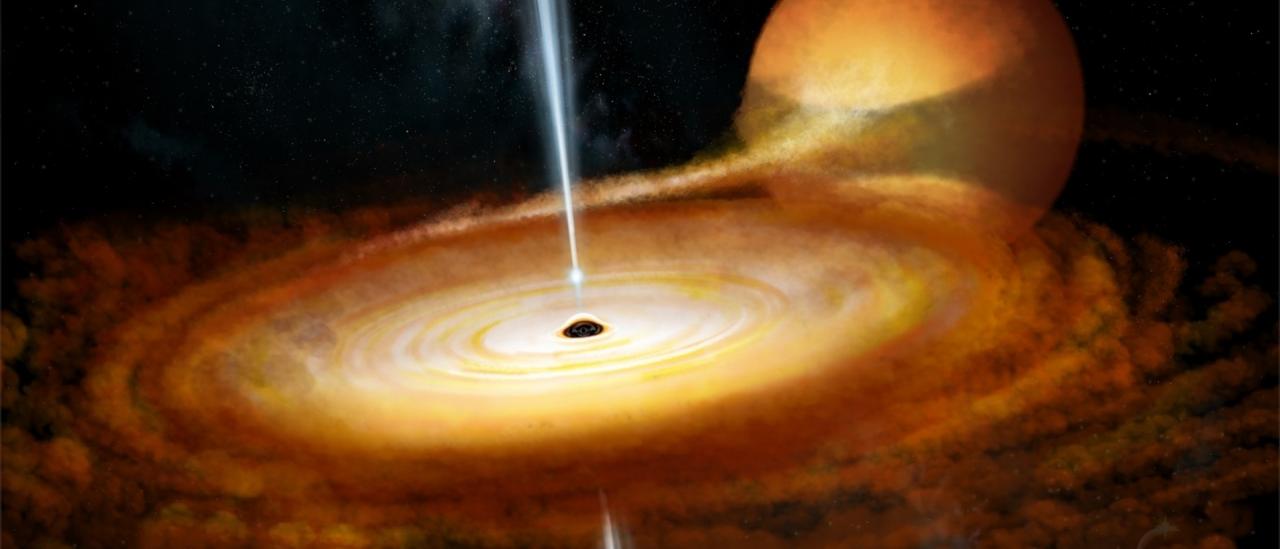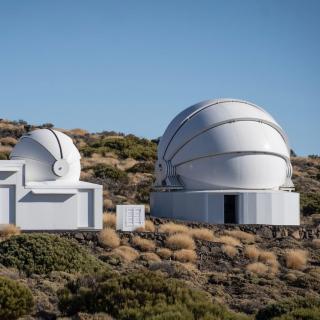A international team of astronomers, led by the University of Southampton and with participation by the Instituto de Astrofísica de Canarias has used the camera HiPERCAM on the Gran Telescopio Canarias NASA’s NICER space observatory to make a high frame-rate movie of a growing black hole system. In the process they have discoverd violent flares in visible light and in X-rays which give new clues to help understand the immediate surroundings of these intriguing objects. The results of this study are published in the prestigious journal Monthly Notices of the Royal Astronomical Society (MNRAS).
Stellar mass black holes can grow by feeding off a nearby star, creating huge discs of gas and dust. The effect of the extremely strong gravity of the black hole, and the magnetic field of the material can cause the whole system to emit radiation with very rapid variations. This radiation is what has been detected at visible wavelengths with the HiPERCAM camera on the Gran Telescopio Canarias (GTC), and in X-rays by NASA’s NICER observatory on board the International Space Station.
The black hole system studied is named MAXI J1820+070, and was first discovered in early 2018. It is only about 10,000 lightyears away, in our own Milky Way. It weighs the equivalent of about 7 Suns, with this mass collapsed down to a region of space smaller than the city of London. Investigating these systems is usually very difficult, as their distances make them too faint and too small to see. However, the HiPERCAM and NICER instruments let the researchers record ‘movies’ of the changing light from the system at over three hundred frames per second, capturing violent ‘crackling’ and ‘flaring’ of visible and X-ray light.
To make the movie, which has just been presented, they used real data, but reduced to a tenth of its true velocity to allow the quickest flares to be detected by the human eye, because some of them last only for milliseconds and the material around the black hole is so bright that it effectively eclipses the star which is being consumed. The researchers found that decreases in brightness of the X-rays happened at the same time as increases in the visible light, and viceversa. The observations also show how the most rapid bursts in visible light occur a fraction of a second after the bursts in X-rays, a phenomenon which had been seen previously in black-hole systems but never with the degree of detail seen in this case.
According to John Paice, a graduate student at the University of Southampton and the principal author of the article, “the fact that we have now seen this in three systems strengthens the idea that this is a common characteristic in these growin black holes. If this is true it may be telling us something basic about the working of the flows of matter around these intriguing cosmic objects”.
Understanding the physics and the nature of these flows of matter around black holes is a hot topic in astrophysics research. Tariq Shahbaz, a researcher at the IAC who participated in this work considers that “The data obtained with HiPERCAM are amazing because the observations suggest than we may be seeing signs of stratification with the regions around the base of the jet".
Romano Corradi, Director of the GTC picks out the way that new instruments are helping us to a better understanding of these phenomena. “Thesee results are a clear example of how a large area collector such as teh GTC and the unique capacities of HiPERCAM to obtain images at high velocity and in various colours at the same time are opening up new areas of study of the phenomena in the universe which vary rapidly”.
This research has been supported by funding from the Science and Technology Facilities Council of the UK, the University of Southampton, the UK-India Education and Research Initiative thematic Partnerships, the University Scholarships Commission (India), the National Programme of High Energies (France), the National Research Agency (France), the Ministry of Economy and Companies (spain) the Finnish Academy and the European Research Council.
Article: J. A. Paice, P. Gandhi, T. Shahbaz et al. "A Black Hole X-ray Binary at ∼100 Hz: Multiwavelength Timing of MAXI J1820+070 with HiPERCAM and NICER". MNRAS Letters, oct 2019, slz148. DOI: https://doi.org/10.1093/mnrasl/slz148
More information:
Press release University of Southampton
Vídeo: Draft animation of MAXI J1820+070 violent flaring (with FLASHING LIGHT!)
Contact:
Tariq Shahbaz, researcher at IAC: tsh [at] iac.es (tsh[at]iac[dot]es)




